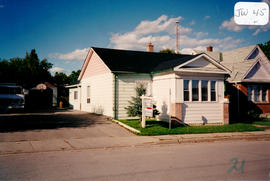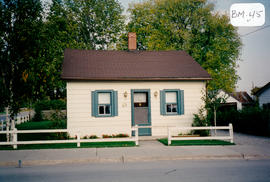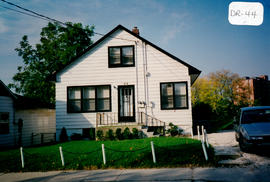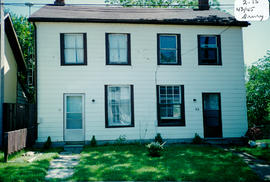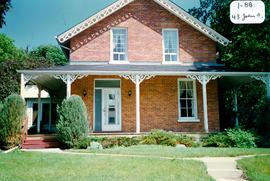The Edmund Garrett House is a two-storey building located at 45 Holland St. East. It was built in the Classic Revival style in the 1880’s (after the fire of 1871 that destroyed much of Bradford’s downtown). The building was converted into two living quarters many years ago and was once the home of the VanZants (on the west side) and the Bennett family (on the east side). George Bennett, a powerful man and labourer, dug (by hand) a large number of the ditches on Dufferin Street. Howard Thornton eventually bought the building and started a crate factory with Bill Fuller in the barns at the rear. He had a crate and lumber yard on Back Street. Howard and his brother also owned Barron’s Hardware store. After Howard died, Mrs. Thornton rented the upstairs apartment and lived downstairs by herself. After her death, the town bought the structure and had it remodeled to accommodate the Bradford Police Station on the ground floor, which it housed from 1980-2008, and the building inspectors’ office on the upper floor.
The building has a modified, rectangular ‘temple’ plan with a projecting frontispiece flanked by two-storey wings on either side. A medium-pitched, gable roof has a plain cornice and frieze supported on small brackets. There is an enclosed, raised porch with a shed roof and a plain cornice and frieze supported on small brackets. The building has tall, narrow window openings with high floor to ceiling heights. Windows are used to highlight the frontispiece with an angular, flat-roofed bay at the ground level and a projecting cornice and eaves on brackets. Double, semi-circular, arched windows at the second floor are highlighted with dichromatic, brick voussoirs. There is a rose window set within the gable into a round opening of cut-stone voussoirs. Other windows are set into rectangular openings with stone (or concrete) lintels and lug sills. The original windows were probably multi-paned and double-hung. Masonry construction has brick cladding and there is a coursed, rubble-stone foundation. The two, two-storey additions have filled in the east corners of the building and the entrance porch has been modified and enclosed. According to the 2000 inventory, the structure is in good condition with some original details remaining. (1, 2, 3)

